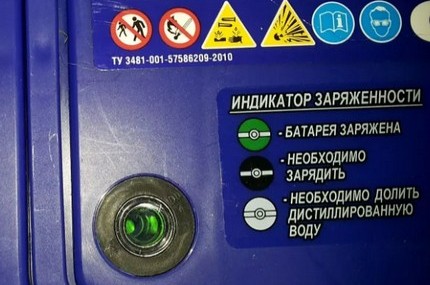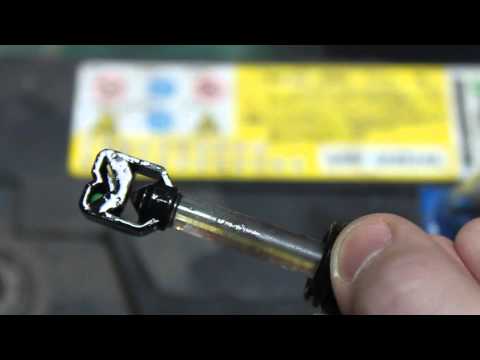
Eye on the battery
Content
Some car batteries are equipped with a charge indicator, often called a peephole. Usually, its green color indicates that the battery is in order, red indicates the need to charge, and white or black indicates the need to add water. Many drivers make their battery maintenance decisions based on the built-in indicator. However, its readings do not always correspond to the actual state of the battery. You can learn about what is inside the eye of the battery, how it works and why it cannot be unconditionally trusted, from this article.
Where is the battery eye located and how does it work?
The eye of the battery indicator outside looks like a transparent round window, which is located on the top cover of the battery, most often near the central cans. The battery indicator itself is a float-type liquid hydrometer. The operation and use of this device is described in detail here.

Why you need a peephole in the battery and how it works: video
The principle of operation of the battery charge indicator is based on measuring the density of the electrolyte. Under the eye on the cover is a light-guide tube, the tip of which is immersed in acid. The tip contains multi-colored balls of different materials that float at a certain value of the density of the acid filling the battery. Thanks to the light guide, the color of the ball is clearly visible through the window. If the eye remains black or white, this indicates a lack of electrolyte and the need to top up with distilled water, or a battery or indicator failure.
What does the color of the battery indicator mean?
The color of the battery charge indicator in a certain state depends on the manufacturer. And although there is no single standard, most often you can see the following colors in the eye:
Battery indicator colors
- Green - the battery is 80-100% charged, the electrolyte level is normal, the electrolyte density is above 1,25 g/cm3 (∓0,01 g/cm3).
- Red - the charge level is below 60-80%, the electrolyte density has fallen below 1,23 g / cm3 (∓0,01 g / cm3), but its level is normal.
- White or black - the electrolyte level has dropped, you need to add water and charge the battery. This color can also indicate a low battery level.
The exact information about the color of the indicator and its meaning is contained in the battery passport or on top of its label.
What does the black eye on the battery mean?
Black eye of charging indicator
A black eye on the battery can appear for two reasons:
- Decreased battery capacity. This option is suitable for batteries that do not have a red ball in the indicator. Due to the low density of the electrolyte, the green ball does not float, so you see the black color on the bottom of the light guide tube.
- The electrolyte level has decreased - due to the low level of acid, none of the balls can float to the surface. If, according to the instructions in such a situation, the indicator should be white, then it is contaminated with the decay products of the battery plates.
Why does the battery eye not show correctly?
Even among conventional hydrometers, float-type instruments are considered the least accurate. This also applies to the built-in battery indicators. The following are options and reasons why the color of the battery eye does not reflect its actual state.
How battery indicators work
- The peephole on a discharged battery may remain green in cold weather. The density of the battery electrolyte increases with decreasing temperature. At +25°C and a density of 1,21 g/cm3, corresponding to a charge of 60%, the indicator eye would be red. But at -20°C, the density of the electrolyte increases by 0,04 g/cm³, so the indicator remains green even if the battery is half discharged.
- The indicator reflects the state of the electrolyte only in the bank in which it is installed. The level and density of the liquid in the rest may be different.
- After topping up the electrolyte to the desired level, the indicator readings may be incorrect. The water will naturally mix with the acid after 6-8 hours.
- The indicator may become cloudy, and the balls in it may be deformed or stuck in one position.
- The peephole will not allow you to find out the condition of the plates. Even if they crumbled, shorted or covered with sulfate, the density will be normal, but the battery will not actually hold a charge.
For the reasons described above, you should not rely solely on the built-in indication. For a reliable assessment of the condition of the battery being serviced, it is necessary to measure the level and density of the electrolyte in all banks. The charge and wear of a maintenance-free battery can be checked using a multimeter, load plug, or diagnostic tool.
Why does the eye on the battery not show green after charging?
The design of the battery charge indicator
Often there is a situation when, after charging the battery, the eye does not turn green. This happens for the following reasons:
- Balls stuck. in order to release something, you need to knock on the window or, if possible, unscrew the hydrometer and shake it.
- The destruction of the plates led to contamination of the indicator and electrolyte, so the ball is not visible.
- When charging, the electrolyte boiled away and its level dropped below normal.
Frequent Questions
What does the peephole on the battery show?
The color of the eye on the battery indicates the current state of the battery depending on the electrolyte level and its density.
What color should the battery indicator light up?
If the electrolyte level and density are normal, the battery indicator should light green. Please note that sometimes, for example in cold weather, this may not reflect the actual condition of the battery.
How does the battery charge indicator work?
The charging indicator works on the principle of a float hydrometer. Depending on the density of the electrolyte, multi-colored balls float to the surface, the color of which is visible through the window thanks to the light-guide tube.
How do I know if the battery is fully charged?
This can be done with a voltmeter or load plug. The built-in battery indicator determines the density of the electrolyte with low accuracy, depending on external conditions, and only in the bank where it is installed.

